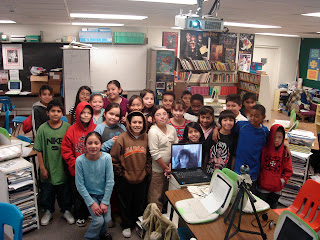Back To the Future
This was a video of Mr. Crosby and how he teaches his fourth graders at Agnes Risley Elementary School which is in Sparks, Nevada. At the beginning, Mr. Crosby stresses that ninety percent of the students in his class are second language learners, most on free or reduced lunch packages, and that most are from families that are facing poverty. He also informed me of a survey that he had his students take on the second day of school that had just a few simple questions. The outcome of the survey was that nine students knew what city they live in, twelve students knew what state they live in, three students knew what country they live in, seven knew their address, and four knew their home phone number. I was completely shocked finding out that most of these nine years olds don’t know the correct answer to such important questions. I know four year olds that could answer all of the questions right and give you surprising information that would leave your jaw dropped by the information they know. Mr. Crosby informs me that these students suffer from having a narrowed curriculum because they have not had the experience to build the schema of the world; therefore, he enlightens the students by using technology and being creative.
In his class, his students use digital cameras, videos, experiments, and blogs to expand the kids learning experiences. Throughout the school year, his students perform experiments that are recorded on digital cameras and they have to write what happen in the video. Also he informed me that he teaches his students how to put together a Wikipedia webpage, paste pictures on blogs. I think that Mr. Crosby’s ways of teaching benefits his students in expanding their knowledge of the second language by writing and using Skype. He makes learning interactive for students that usually would not even try because they feel like they are in a different world due to their lack of knowledge. Mr. Crosby and his students also created a project that involved recording a balloon traveling through the atmosphere and as the balloon traveled the students could actually see it happening live. He then had his students write as if they were the balloon traveling through the atmosphere. The main aspect that I learned from viewing this video was that you have to go the next step, no matter what it may be, to help our students learn effectively. This has to be a fun experience for his students that are learning through interactive assignments and connecting to other students around the world.
A Vision of Students Today
This was a video created by Michael Wesch. The video contained information from students at Kansas State University and took place in what looked to be a college auditorium. Throughout the video, there were statements written on the walls, chairs, and board in the room. Also, there were students in the video that displayed facts about themselves and questions by writing on paper to express their concerns of school. The question in the video, “What are you learning sitting here?”, I thought was a excellent questions because students are in this large classroom being taught by one teacher. I feel like teachers that are instructing these classes are not being able give adequate assistance to every student.
Another statement that caught my eye was “My neighbor never comes to class but paid for class”. I think that this statement can be really controversial. I know numerous students that pay for classes and only attend them when there are things due because they usually have other important things to do like going to work. I think this could be avoided if all universities uploaded lectures online for students that can not make it to class; on the other hand, teachers normally look at a student that are constantly absent as a disadvantage for them because they missed out on hearing the important information from the instructor. Overall, this video made me think of different ways that technology can benefit students and teachers in the classroom.


No comments:
Post a Comment